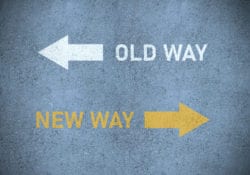Strong Point’s Leadership Rule #10: Teach and Strengthen Core Competencies
It’s been almost thirty years since C.K. Prahalad and Gary Hamel introduced the idea of core competence into business management literature and practice. In a Harvard Business Review Article dated May-June 1990 entitled The Core Competence of the Corporation, the two business academics wrote about Core Competencies in this way:
”Core competencies are the collective learning in the organisation, especially how to co-ordinate diverse production skills and integrate multiple streams of technologies…core competence is communication, involvement and a deep commitment to working across organisational boundaries…core competence does not diminish with use. Unlike physical assets, which do deteriorate over time, competencies are enhanced as they are applied and shared.”
In the article, the two authors quite visually describe Core Competencies using a tree metaphor. They explain that the corporation can be seen as a tree whose roots are its particular competencies. In this image, the core competencies are the roots from which the company can build core products and services. Core products and services become the trunk and major limbs of the company’s offerings. The smaller branches are business units. The leaves, the flowers and fruits are the end products and services that grow from the roots, through the trunk and limbs to produce fruitful outcomes. Using C.K.’s and Gary’s tree metaphor, Business Units and Key Initiative or Project Teams, build the business on and around the company’s competencies (the roots), and core products and services (the trunk and main branches).
In Strong Point’s last leadership rule, Rule #9: Work with Deep People, I talked about the importance of defining Leadership Characteristics and developing and strengthening them organizationally through the implementation of a Leadership Competency Model. Core Competencies and Competency Models are important components of any Leadership Development effort. Leaders who know their own core competencies, as well as those of their peers, teams and operating culture(s); and develop them are more effective than those who don’t. Strong Point’s Leadership Rule #5 (It Matters Who – It Matters How) and Rule #7 (Use Your Mirrors, Know Your Impact) reinforce the importance of completing a Phase I Leadership Assessment and conducting Team Setting Activities to better understand and strengthen core competencies.
In an RBL Group White Paper Series, called Competency Models with Impact: Research Findings from the Top Companies for Leaders, authors Erin Wilson Burns, Laurence Smith, and Dave Ulrich share the results of one of the most comprehensive studies of talent management and leadership practices ever conducted or published. The study was sponsored between 2002 and 2011. Results were compiled through data collected from answers to a 42-page questionnaire that focused on descriptive leadership practices (e.g., do you have a succession system? or what are the competencies in your leadership model?) more than the evaluation of such practices. The RBL Group published the findings gathered from their own research. The results of the study were also published in the November 4, 2011 issue of Fortune Magazine Fortune Magazine.
478 companies participated, in the RBL Group leadership study. Results showed that over 74% of responding companies indicated they had a defined leadership competency model that described a unified theory of what leaders should be, know, and do. A full 100% of companies that made it to the study’s “Global Top Companies” list used, and are continuing to use a Leadership Competency Model.
Beyond Leadership Capability and Performance, explicit competency models can be developed for functional skills. In an example engagement, Strong Point was asked to assess and define the Core Competencies of a 25 member Leadership Team. The exercise included a detailed review of many core documents related to and associated with each leader’s work.
The documents reviewed in the competency assessment included:
- Resumes and Other Professional Credentials and Documents
- Job and/or Role Descriptions related to each Leader’s position in the company
- Performance Reviews and Professional Development Plans
- Other Skill-Based Training and/or Mentoring Documentation and Certificates
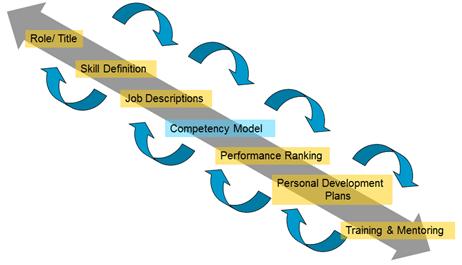
The results demonstrated that the group possessed 8 Core Competencies. They were:
- Technical
- Project Management
- Customer Relationship Management
- Business Analysis
- Training and Change Management
- Communication
- People Management
- Leadership
In this engagement, Leadership Competency appeared as one of the eight Core Competencies present among the group. Using the competency model as a baseline, the Vice President and Senior Leader of the leadership team, then graded, through his own value judgment, every leader on the team according to the model. He shared back his opinion and results with the whole team. Every Leader’s Core and Complementary strengths were shown to the group in this way:
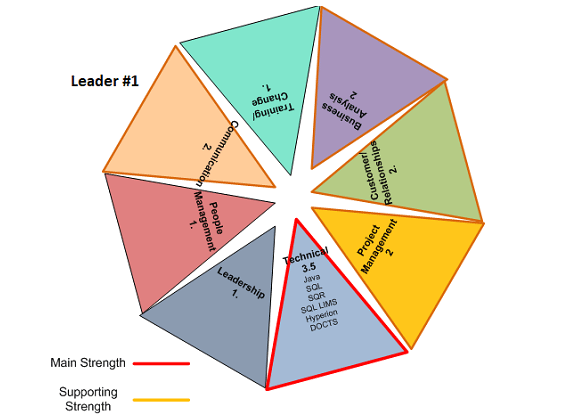
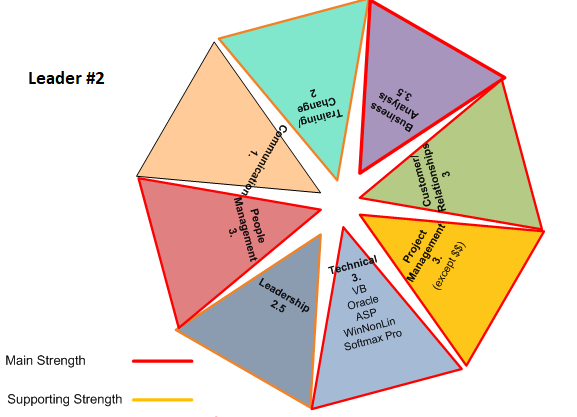
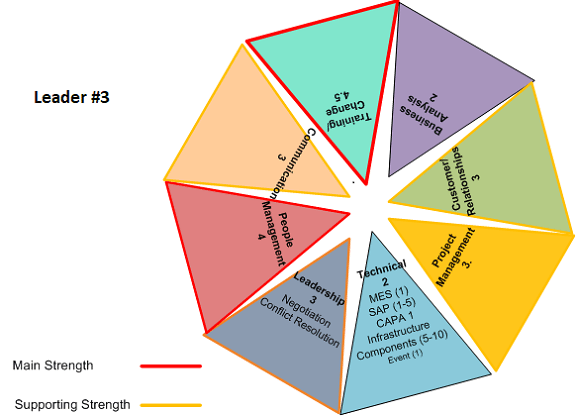
Some Leaders possessed a single, strong core strength (ex: Technical). Others had strength in two or three core competencies. Still, others showed strength in a few core area such as: Customer Relationship Management, and People Management, but could use strengthening in other core competencies such as: Business Analysis and Project Management.
Besides gaining full knowledge of the team’s core strengths as a whole, the assessment provided the team’s leader with insight into the specific strengths of each leader on his team.
The competency assessment exercise was emotionally challenging for everyone involved. It left the leadership team members feeling vulnerable and exposed, as any shared assessment can. The intended outcome of the assessment was to show and share with the group, the unknown or previously unused strengths of the group. The somewhat painful, yet important benefit gained by the team, was the knowledge of which team members could provide meaningful support for specific project activities when outside resources were not available. The assessment also provided the team with detailed ideas for how they could nimbly reshape and reorganize themselves to meet ever-changing customer demand. Difficult as it was, the exercise was deeply empowering and incredibly productive. The group learned how truly complimentary their skills were, and how each leader could help another and the group, more fully. The competency assessment was the first step in a year-long journey that helped this team unleash its latent potential and exceed both its leadership and service goals for the year. The results were recognizable to everyone in the company. This team provided:
- Projects that were more fully supported by internal resources
- Richer outcomes achieved with faster delivery
- Deeper Analysis and more meaningful Insights
- Stronger and deeper Customer Relationships
- Infectious team solidarity
- Employee and customer engagement that flashed to new heights
An August 2015 McKinsey & Company Operations article entitled: Experiential learning: What’s missing in most change programs By Claus Benkert and Nick van Dam claimed:
“In the workplace, experiential learning has a long tradition, having proved itself over time to be the most effective means to acquire skills. It is an essential component in the functioning of society and in economic well-being—as the ubiquity of internships, apprenticeship programs, and on-the-job training shows. When it comes to the systematic acquisition of the knowledge and skills needed to support business transformations, success depends on a combination of intellectual comprehension and hands-on experience. In modern corporate settings, effective capability builders rely on dedicated experiential-learning programs to achieve the results they need. Our latest research shows, however, that too many companies struggle with capability challenges while leaving the path of experiential learning unexplored.”
Teaching and strengthening Core Competencies is not a “do it once and you’re done” exercise. Developing Core Competence requires constant effort. It must be tackled and accomplished in the organization from the Top-Down and the Bottom-Up. Building a Core Competency Development Lab and Circles of Learning help Leaders synchronize and strengthen core competencies among a disparate group of professionals. This was the essence of Stephen Covey’s “Sharpen the Saw” Rule. He believed, as I do, that we can, through our conscious, meaningful and consistent effort, focus on and strengthen core competencies to inspire and enable progress, growth, change, and constant improvement. In essence, we should always endeavor to “start anew” in an effort to integrate and master core competencies. This attitude helps leaders and subordinates maintain mastery over the core skills that build the business and sustain growth. Competency Labs allow leaders to standardize and synchronize core competencies and enable more predictable outcomes from efforts. Competency Labs provide the forum and support to bring operational actions to standard levels of expected execution.
In adult learning theory, achieving mastery of a core competency requires the leader or learner (leaders are continuous learners) to move from Stage 3 of Learning (Conscious Competence) to Stage 4 (Unconscious Competence). Restated, this means a leader begins to master the art and science of taking knowledge, skill and learning from inside his or her head, to the business operating environment by experiencing and creating real-world results. Executed again, and again, a core competency becomes internalized or second nature (i.e. mastery). The implementation and management of a Competency Development Lab can help leaders and individuals alike, learn on-the-job. Skills like Project Management, Business Analysis, and Communication, while they are universal in many aspects; are most effectively used, when leaders know how to apply these skills in a specific operating environment and culture.
The Competency Development Lab is also a place where leaders have the opportunity to shape the company’s core competencies and culture while responding to the ways emerging leaders exhibit and transform leadership capability through authentic action and results.
| Business Development Methodology | Leadership Development Methodology |
|---|---|
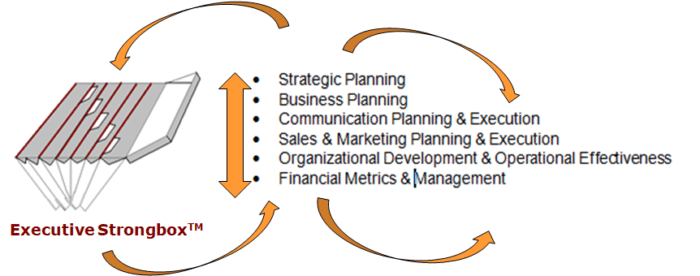 | 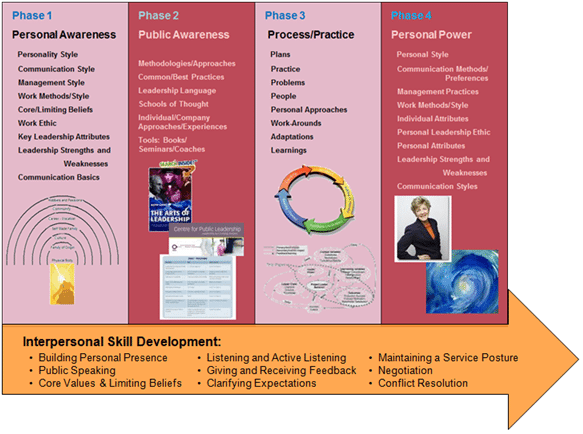 |
| Core Competencies | Core Competencies |
|
|
A Harvard Business Review Leadership Article dated December 30, 2015, and written by Paul Leinwand, Cesare Mainardi and Art Kleiner purports that only 8% of leaders excel at both strategy and execution. Strong Point has experienced this statistic as reality in its work with clients. Companies that demonstrate competence and strength in both Business and Leadership Building maintain market leadership. Competency Development is a key component of Leadership Development.
Strong Point’s Leadership Rule #10: Teach and Strengthen Core Competencies

